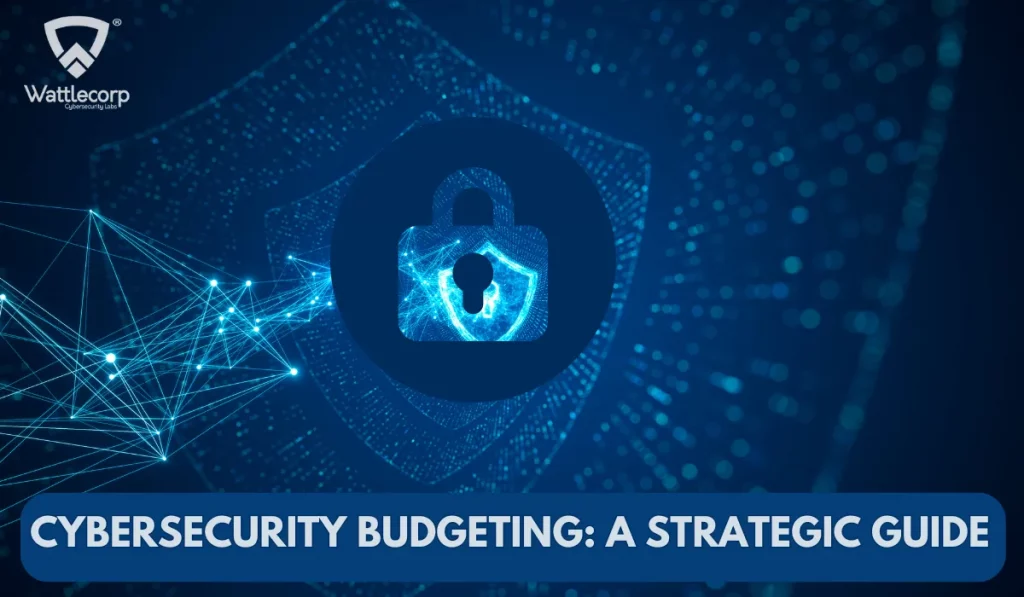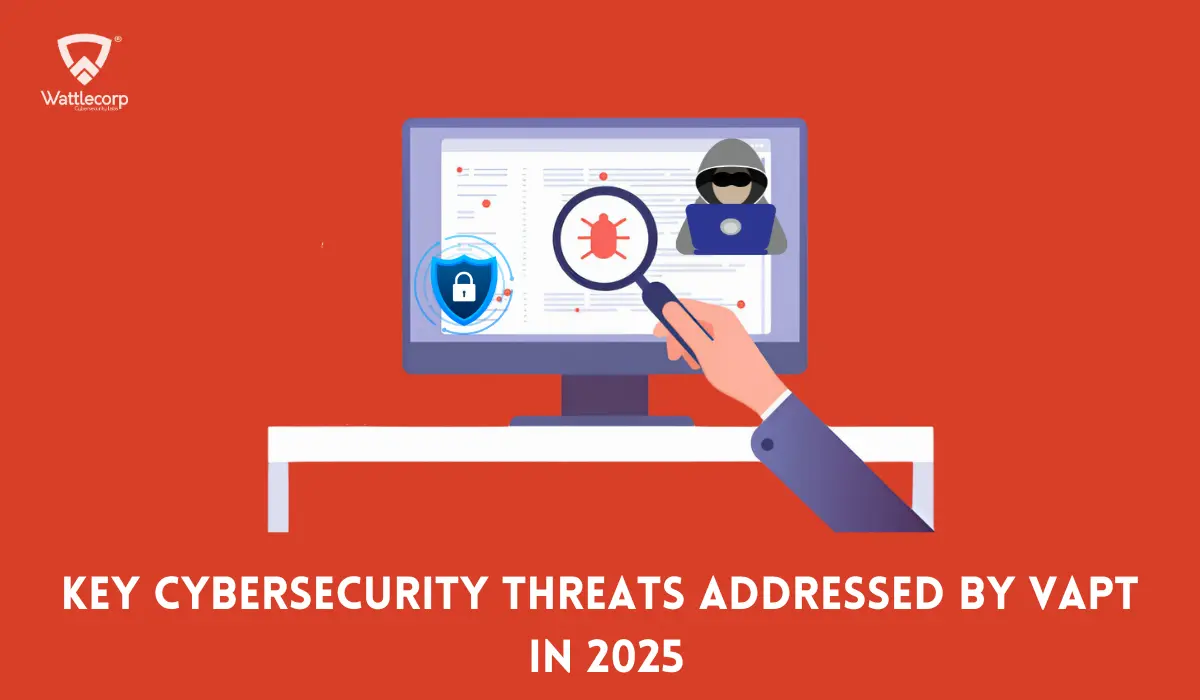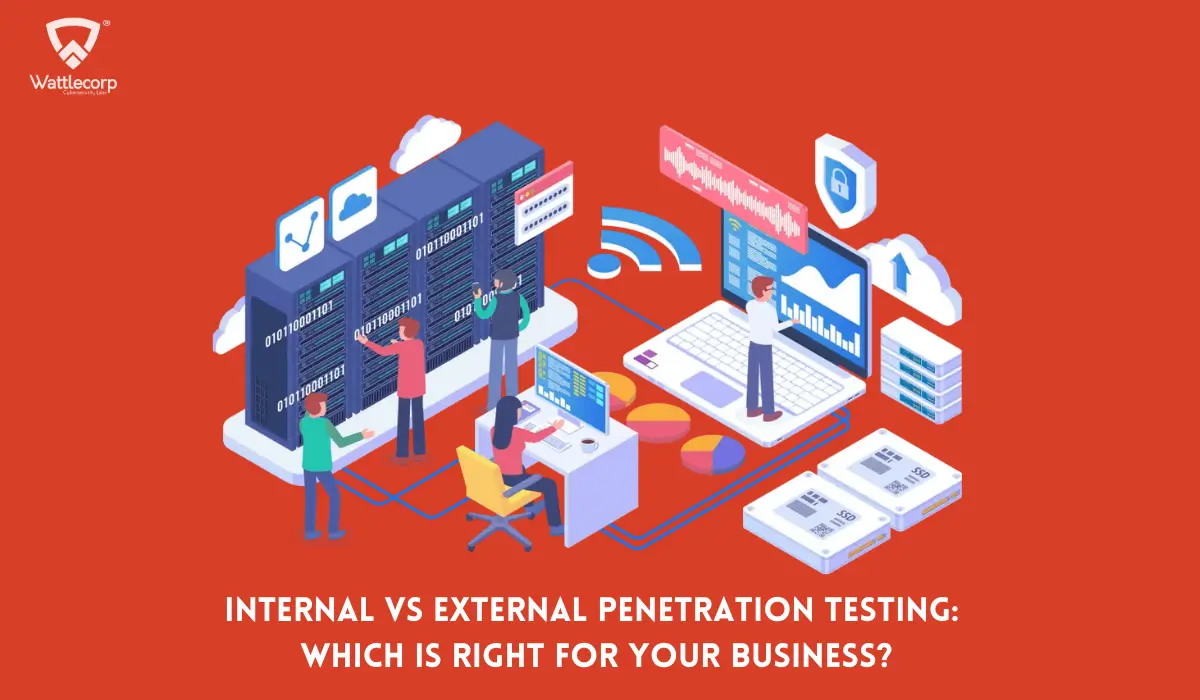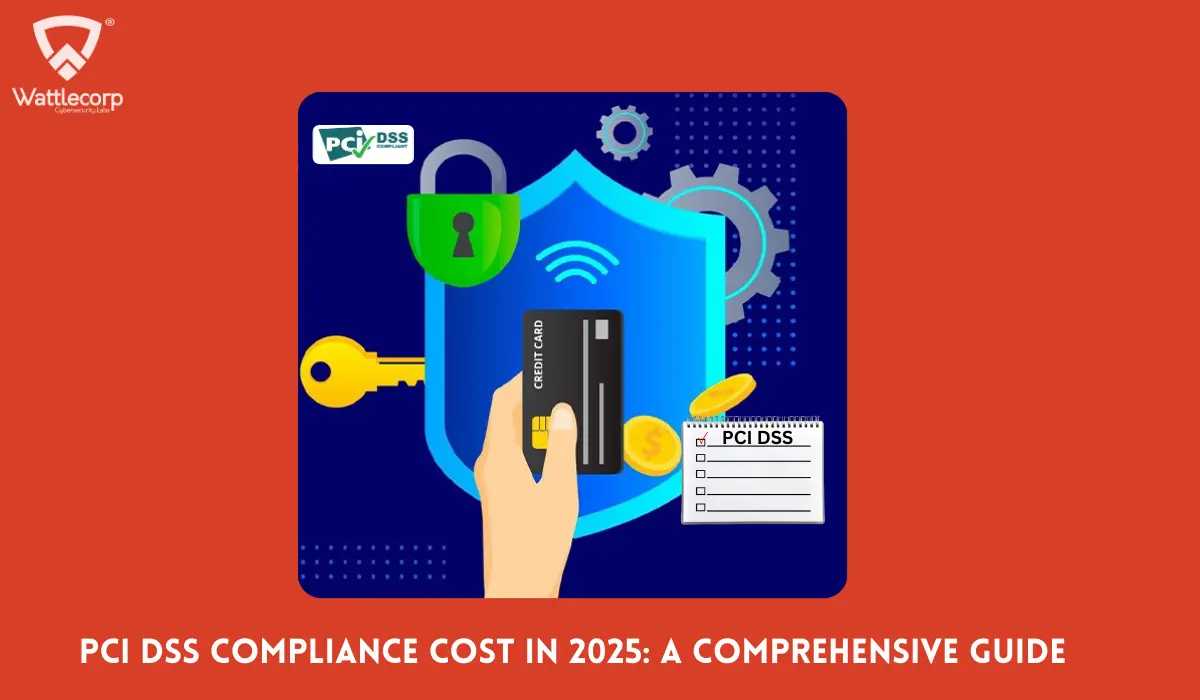SECURE YOUR BUSINESS WITH EXPERT VAPT STRATEGIES
How Secure Is Your Infrastructure? Book a Free Consultation with Wattlecorp’s Experts to identify vulnerabilities, develop a robust VAPT strategy, and safeguard your business with tailored protection solutions.

Cyberattacks are deliberate and malicious attempts that an organization or an individual performs to breach the information system that belongs to another entity. Generally, through disrupting someone’s network, the attacker gains some kind of benefit for themselves or their organization. Hackers adopt different types of cyberattacks for various businesses.
Cybersecurity incidents can paralyze your business activity and destroy customer trust, making the recovery from these attacks highly expensive. To prevent these potential consequences, businesses should be involved in ensuring cybersecurity across all stages of their operations.
Like many core business processes, cybersecurity should also involve planning and budgeting. But, how much should you invest and what should be your cybersecurity budget to augment your cyber defense mechanism completely?
Let’s dive deeper into the best practices of cybersecurity budget analysis, cyberattack costs, and the best ways to make a feasible cybersecurity budget for a secure buy-in.
Table of Contents
ToggleNeeds to Establish a Cybersecurity Budget
Let’s take a look at the benefits of having an appropriate cybersecurity budget for your business:

- Securing your business: A cybersecurity budget helps to fund the programs that safeguard your company against the costs and disruptions caused by cyberattacks.
- Fulfilling the risk assessment clauses: A funded cybersecurity plan is a safety measure that includes third-party cybersecurity risk assessments. The risk assessment clauses are becoming highly prevalent in contracts.
- Compliance support: A cybersecurity budget lets you comply with GDPR, HIPAA, and other state/national regulations required for companies to maintain cybersecurity standards legally.
- Keeping your firm competitive: Following cybersecurity helps you compete for large contracts or projects.
How Much Should You Invest in Your Cybersecurity Budget?
There is no specific answer on how much organizations should invest in their cybersecurity budget. This amount generally varies since organizations confront a different risk level that depends on the industry, company size, compliance, regulatory requirements, data collected and stored, and the needs of the clients and partners.

The attacks prevalent in the modern generation include malware, phishing, man-in-the-middle attacks, Denial-of-service attacks, zero-day exploits, DNS tunneling, etc. The cyber security budget can vary based on the intensity of the attack the organization encountered and the nature of the cybersecurity system the business wishes to adopt.
For instance, a small healthcare practice that manages patient health data should adhere to government regulations such as HIPAA (Health Insurance Portability and Accountability Act) to find it ideal to invest in cybersecurity tools and technologies. On the contrary, a small automobile repair shop having the least scope of conducting business online might not need anything more than a basic toolset to secure its customer database and email system.
The thumb rule of cybersecurity investment states businesses should spend between 7%-20% of their IT budget on cybersecurity. Organizations can use this money to support various cybersecurity-related tasks such as software purchase, monitoring, upscaling of the IT staff, cyber security awareness, training, and more.
Factors That Influence Cybersecurity Costs
a) Business Complexity
Though it’s obvious that bigger organizations invest in overall cyber security, smaller businesses are also inclined towards spending more on cyber security. Regardless of the business size, cyber security is an inevitable tool to protect customers and their data against increasing cybersecurity threats. While a typical enterprise invests about 9.9% of the IT budget, an SMB might spend over 20% on cybersecurity.
b) GDPR Compliance:
GDPR is an influential factor that forces businesses to adopt cyber security measures to align their process with cybersecurity compliance standards. At least one of two organizations agree that GDPR compliance has persuaded them to spend more on cyber security.
3. Sensitive Data
Sensitive data is exposed to cyber security attacks and the theft of highly confidential information can cost a huge loss to the firm. Organizations that manage sensitive data should invest more in data security.
4)Type of Business
According to the Security Spending Benchmark Report, organizations in the technological and business sectors invest over 13% of their total budgets on cyber security. This is because the biggest cybersecurity investors belong to the tech and business services.
5) Cyber Insurance
Cyber insurance is a must-have unless you are completely certain that your organization’s cybersecurity is invincible. Cyber insurance policies help you cover the financial impact that cyber security incidents can cause. The cyber security insurance premium depends on how well you can answer different security questionnaires an insurance provider asks.
What Would be the Cost Of a Data Breach?
Cyberattacks can result in significant expenses and damages to your organization. As per the IBM Cost of a Data Breach report, the average value of the impact of a data breach on organizations with 500 employees or less is USD 3.31 million, and the average cost per breach is USD 164. The full cost of a data breach isn’t always known quickly.

The potential direct costs can include:
- Monetary theft
- Regulatory and compliance fines
- Remediation and system maintenance
- Legal and PR fees
- Increase in insurance premium
- Notification, credit monitoring, and identity theft repair for affected parties
Potential indirect costs can include:
- Business disruption
- Loss of customers or business
- Business downtime
- Loss of intellectual property
- Damage to the brand, company credibility, and reputation
Having an incident response team, a cybersecurity plan, using encryption methods, and engaging in employee training and cyber insurance can help minimize the cost of a data breach.
The concept of cyber resilience is gaining global significance. With an understanding of the expenses and consequences of a data breach on your business, the budget you dedicate to enhance the organization’s cybersecurity posture should be aligned accordingly.
How to Make a Cybersecurity Budget?
As a decision maker for your organization, building a cybersecurity budget needs careful consideration with many factors on the table, including the cost involved, quality of service, etc. Here are seven simple steps that help you establish a well-defined, cybersecurity budget breakdown for your organization.
1. Evaluation of Existing Cybersecurity Posture
Every organization has its vulnerability regardless of the operation they perform. The first step towards planning a cybersecurity budget is to understand the security gaps in the existing system. While this is not practically easy, it could be easier when you hire a team for penetration testing or other security services, which helps you to grasp the existing situation of your cyber security systems. Analyzing your budget allocation and the areas of most demand should be precise. By investing time upfront to understand where network security is essential, you can know how to calculate the costs based on the scope.
2. Identification of Key Assets
Similar to finding vulnerabilities within your existing system, you should also pinpoint the assets you wish to safeguard. The most sensitive data can defer based on the client and might need various levels of effort to protect. Let’s take a glance at a few types of assets you can list as most essential for a security team to adopt:
- Sensitive Data
- Key Personnel
- Critical Infrastructure
Each of the above needs a different data protection method, hence understanding which assets are the most vital to your mission is important to make a precise overall budget allocation. Ensure you include those assets you believe will need the highest protection based on the discussion with cybersecurity service providers.
3. Prioritize the Allocation of Budgets
It’s easy to say that you need full-coverage solutions across all the core assets, however, it’s equally mandatory to afford every protection. This shows the importance of budget allocation— dictating what we can spend and where. After highlighting your assets, it’s time to exercise.
Ensure risk-based budgeting, i.e., how vulnerable they are for the organization. High-risk assets should be given the maximum funding in the cybersecurity budget. But, those assets with low-risk attributes can be assigned less funding as there’s less chance that a cybercriminal would breach this part of the system.
4. Consider Both Short-Term and Long-Term Requirements
Cybersecurity budgets are distinct in their requirement to meet short-term and long-term goals. Particularly when you plan to engage with the cybersecurity firm for the long term, considering the urgent vs can-wait priorities is an ideal way to prioritize the tasks. For example, a short-term project is what your organization requires in high priority within the IT security efforts, which include software patches, updates, etc.
On the contrary, Long-term solutions are the projects that need a big lift to implement. They could be prioritized later since quick wins are examined earliest. However, this should not bring down the value of long-term projects. Investments in novel and top-notch technologies/infrastructure are examples of long-term costs.
5. Allocate Funds to Expedite Incident Response and Recovery
Incident response is a core area in which every business hopes to avoid investing. But, it is essential to focus on how cyber threats impact your business and how you will recover from a potential attack. Even if you met with no cybersecurity incident in the past, a plan in place is significant to address the possibility of a future incident. Below are the ideal steps companies should adopt to respond to a cyber incident:
- Prepare systems and procedures
- Understand the incident
- Contain the attacker and the after-effects of the incident
- Obstruct the possibility of re-entry of the attacker
- Execute the recovery process with the incident and restore systems
- Review the lessons and implement the information for the incident that follows
You should spend time finding out how to manage a real incident. To maintain a process that effectively adheres to all the above steps, you need to understand cybersecurity budget trends and collaborate with the cybersecurity professionals, or in-house teammates for a detailed plan.
With an incident response plan, you can function with utmost certainty. For this reason, you need to allocate a portion of your budget for response and recovery mechanisms. These expenses include disaster recovery plans or incident response teams. This lets your organization be prepared to manage any possible security incidents.
6. Review and Update the Budget Regularly
Since the threat landscape continuously evolves and poses new challenges to cybersecurity, your budget and collaborative efforts with the companies outside should be reassessed at certain intervals. Implement regular audits of the cyber vulnerabilities and requirements to ensure that the work is aligned with the changing security needs of the organization. Cybersecurity professionals have the expertise to support you in identifying potential threats and weaknesses in the organization’s security posture.
7. Present the Budget to the Management
Any project will function smoothly when the management approves of the plans. This is specifically significant while creating a budget of any type. Hence, a management or CFO needs to approve the cybersecurity requirements.

Though a cybersecurity expert is well aware of the business needs, they can’t completely understand the constraints of the organization. Knowing how to justify cybersecurity spending to the C-suite helps to have essential support and resources to ensure business continuity.
Cybersecurity is not anymore a “good to have” element— it is a must-have that businesses should go for with necessary budget planning. A comprehensive cybersecurity program need not cost much, however, it needs prioritization and commitment of IT, leadership, and other employees.
Regardless of how much you invest in cybersecurity, there is no 100 percent guarantee. Your key objective is to deploy thoughtful cybersecurity budget strategies that use a combination of testing, resources, training, and time. When you can enjoy knowing that the organization is highly protected, the cost of a cybersecurity program is a crucial investment you can make.
FAQ (Frequently Asked Questions)
It could vary based on the organization, industry, geography, and culture. IT cybersecurity budgets can be higher in regulated environments having stringent compliance needs and can increase when a new threat is encountered.
The cybersecurity budget depends on risk assessments, compliance standards, the usage of the latest technologies, and incident response plans. Cybersecurity services providers can help your organization define a practical cybersecurity budget.
If you wonder how to justify cybersecurity spending to the C-suite, present the need for proactive measures to mitigate the threats, Cybersecurity ROI, and the necessity of protecting an organization’s confidential information, along with a detailed cybersecurity budget that justifies the security it offers to the business.








